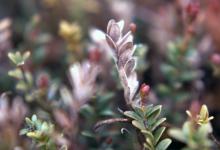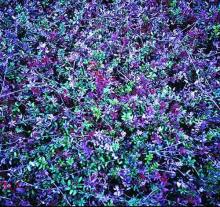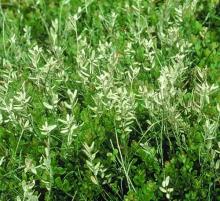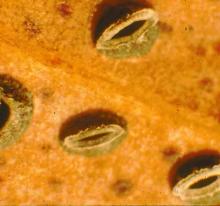Cause Lophodermium oxycocci (the more common species) and L. hypophyllum, fungi. They overwinter as mycelium in last season's leaves. The spores are ejected forcibly into the air, where wind disperses them. New growth is infected between late June and mid-August, but exactly when varies from year to year. Twig blight may be severe the year after planting. Check vines in the second year and protect new growth if needed. This disease can slow the establishment of new beds. Yield on infected uprights is lowered by one-third, and the following year's crop is also impacted as infected uprights are less likely to set a mixed bud for the next crop year.
Symptoms Infected leaves turn from dark brown to bleached tan in late winter and spring and remain attached to the dead uprights. Blighted uprights may be scattered, or they can be in areas ranging from a few feet in diameter to the entire bed. Black, glossy, fruiting bodies (apothecia) begin to form on the lower surfaces of infected leaves in spring. As apothecia mature, they become football-shaped and open along a median slit to release spores.
Cultural control
- Remove trees that cast shadows on the bed. This helps decrease shade and improve air circulation.
- When planting new beds, select cuttings only from beds known to be pathogen-free.
Chemical control Apply during late bloom, July and early August. Control is based on protecting new growth. Research indicates the first spray should be applied 28 days after 50% of the fruiting bodies contain spores.
For all markets:
- Abound at 6 to 15.5 fl oz/A. Do not apply within 3 days of harvest, or with silicone-based surfactants. Do not apply to flooded crop or allow release of irrigation or flood waters for 14 days after application. Highly toxic to fish. Group 11 fungicide. 4-hr reentry.
- Cueva at 0.5 to 2 gal/100 gal water/A. Group M1 fungicide. 4-hr reentry. O
- Cuprofix Ultra 40 Disperss at 5 lb/A. Highly toxic to fish. Group M1 fungicide. 48-hr reentry.
- Dexter Max at 3.2 to 5 lb/A. Do not use within 30 days of harvest. Group M3 + 11 fungicide. 24-hr reentry.
- Ferbam Granuflo at 6.1 lb/A. Do not apply within 28 days after mid-bloom. Toxic to fish. Group M3 fungicide. 24-hr reentry.
- Mancozeb products such as Dithane, Koverall, Manzate Pro-Stick, or Penncozeb 75 DF at 3 to 6 lb/A or 2.4 to 4.8 quarts/A. Do not apply within 30 days of harvest. Can apply through several types of irrigation systems; see manufacturer's directions. Moderately toxic to fish. Group M3 fungicides. 24-hr reentry.
- Mastercop at 3 pints/A. Toxic to fish. Group M1 fungicide. 48-hr reentry. O
- Quadris at 6 to 15.5 fl oz/A. Do not apply with silicone-based surfactants. May be applied on the day of harvest. Group 11 fungicide. 4-hr reentry.
- Quadris Top at 10 to 14 fl oz/A. Do not release irrigation water for 14 days after application or apply within 30 days of harvest. Sprayers should not be used on apples. Group 3 + 11 fungicide. 12-hr reentry.
- Quilt Xcel at 14 to 21 fl oz/A. Do not use on flooded fields, and do not release irrigation water for 14 days after application or apply within 45 days of harvest. Extremely toxic to fish. Group 3 + 11 fungicide. 12-hr reentry.
For domestic markets only: Growers can use chlorothalonil products if their fruit is destined for DOMESTIC markets. Growers should check with their handlers before using any formulation using this active ingredient.
- Chlorothalonil products are registered. Do not apply within 50 days of harvest. Applications in warm weather during or shortly after bloom may reduce yields (Wisconsin data). Do not apply within 25 ft of marine/estuarine water bodies or release irrigation water from beds for 3 days after application. Apply only through solid-set sprinkler irrigation systems. Highly toxic to fish. 12-hr reentry.
- Bravo Weather Stik at 4 to 6.5 pints/A.
- Bravo Ultrex at 3.8 to 6 lb/A.
- Echo 720 at 4 to 7 pints/A.
- Echo 90 DF at 3.25 to 5.75 lb/A.
- Equus 720 SST at 4 to 6.5 pt/A.
Reference Bristow, P.R. and Windom, G.E. 1989. Controlling twig blight and fruit rots of cranberry with fungicides. Fungicide and Nematicide Tests 44:81.






